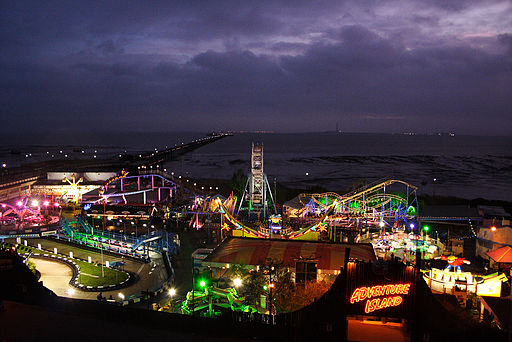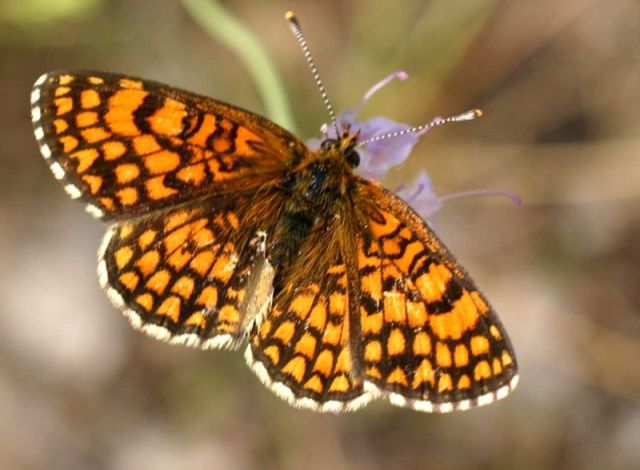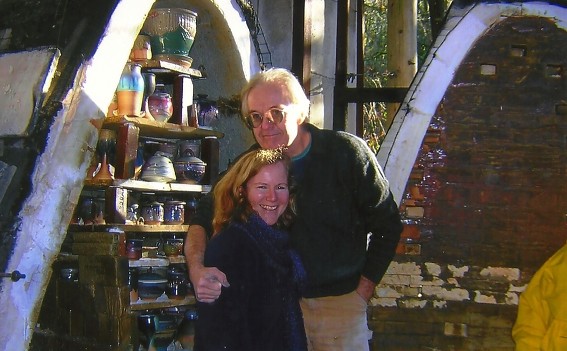The alarm went off at o-dark-thirty so we could get an early start and beat the heat, only the night had been so warm, following daytime temperatures in the eighties, that we’d slept with the fan on and I didn’t hear the alarm until my eyes popped open with the arrival of the sun behind the curtains. Well at least I was going to start this adventure feeling rested and refreshed, I thought to myself.
It had been a good fifteen years since I’d carried a heavy pack into the woods for an overnight with my husband and even though part of me really wanted to do this again, another part of me had been gripping the edge of the metaphorical roller coaster and looking away from the plunge ahead of me. Bracing myself against the “what ifs” of the situation. What if I’m so slow I drive my husband batty waiting for me? What if something happens to him and I have to find my way out when I didn’t actually pay attention on the way in? What if we encounter a bear? Or a cougar? And the big one, the one that kept sidling around from wherever it was lurking to plaster itself over the front of my eyes—what if I can’t heft a backpack anymore?
But I did want to do this. I honestly did want to do it. Especially given the excitement I could see in my husband’s eyes at the prospect. He’d got the packs out three days before our planned departure and carefully loaded them with everything we’d need for one night in the woods. I didn’t pay attention to what he put in mine nor did I try to pick it up; better that I not know and power through when the time came, I told myself. After all, if it had been fifteen years since I’d gone backpacking into the woods that meant, coincidentally, that I was also fifteen years older and, let’s be honest, probably fifteen pounds heavier than the last time. So I didn’t want to do anything that could talk me out of going before I was ready to talk myself into it.
When the time did come to lift my backpack we were at the end point of a logging road, at an elevation of 2800 feet, standing outside our vehicle opposite the trailhead.

I swung the pack onto my shoulders, clipped it over my hips and thought—not bad. Not bad at all. It was eight forty-five a.m. and the day was still teetering on tepid this far up the mountain. I nodded at my husband—I’m ready.
We stepped across the trickling tributaries of Otter Creek on the uphill side of the logging road and started up the moss-covered boulders that formed part of the trail.

We were headed for Enjar Lake, above Slide Lake in the Glacier Peak Wilderness, and this first part of the trail was pretty easy. Not too steep, shaded from the elements by a magical old growth forest of Doug firs and cedar trees, and very much a known quantity for me. It was the first place my husband took me on a date thirty years ago, and I’d won his heart by jumping into the icy water of Slide Lake to retrieve one of his fishing lures. This much I could do with a backpack on, I was sure.
I glanced at my watch when Slide Lake came into view between the trees and realized we’d done this section of the hike fifteen minutes quicker than the last time we’d hiked it. Very encouraging. I knew we still had the tough part to come though. The hike from Slide Lake to Enjar is a fisherman’s trail, flagged periodically by blaze on a downed log or a length of ribbon in a tree, and it’s seriously uphill all the way.


I knew this because we’d day-hiked this trail once before, two summers ago, and it had taken us three and a half hours of slogging to get to the lake. Three and a half hours with lots of pauses for me to catch my breath even though I wasn’t carrying a pack that time, and one major interruption about five minutes from the lake, when I stopped altogether and whined like a two year old in need of a nap, “Are you sure you know where this lake is?” Now I was going to have to make that hike with a full backpack. Was I up for it? Apparently I was.
Fortunately I knew what was at the end of that uphill pull; a lake so clear, so clean, it’s a magical shade of jade green from the reflection of the trees around it on its pristine surface. Plus it has a picture perfect view of Snowking Mountain.


I wanted to see that water again, to be in that place of inspiration and serenity. We followed the start of the trail alongside Slide Lake to its far end, a gentle uphill gradient with a view to our right of the water peeking in and out of the trees.

Then we started climbing. Hundreds of years ago boulders and trees slid down from the top of this mountain ridge forming a natural dam over Otter Creek to create Slide Lake, so in addition to the steepness of the hike into Enjar, the trail involves a lot of climbing over, around or under downed trees and rocks. With a pack on. And then there are what my husband calls “slide chutes”—long, sheer stretches where the ground is unstable, sometimes full of talus still sliding very slowly downhill, where trees cannot root long enough to grow. Instead salmonberry, blueberry and huckleberry bushes, as well as ferns and other low growing brush, take advantage of the available space, covering the dirt and rocks so it’s impossible to see where to put your feet.

I plowed ahead, sweat dripping off my forehead in tiny beads, using the expandable ski pole my husband bought me for this adventure to ensure that I didn’t lose my footing. Yes, my brain may tell me I can still hike with the agility of a twenty-five year old but my body, at more than twice that age, is not persuaded. The ski pole seemed like a wise idea. I was lagging but undeterred, buoyed by the trilling of the songbirds and the tinkling percussion of the creek somewhere to our right. And in the stretches of trail that were wide and mossy, still uphill but not as savagely, I reveled in nature’s aromatherapy; the wild, cilantro-like aroma emanating from the warm foliage and the cheerful reminder of Christmas in the resin from the silver fir trees.

I had promised myself that I would eat more snacks on the way up this time, to give myself longer breaks as well as sustenance, but the air around us was thick with the rising heat of the day and not conducive to appetite. The sweat beads coming down from my forehead quickly developed into a light shower and my hair began to stick to the back of my neck. At three hours in, after we’d just bulldozed our way up what my husband announced as chute two of the four chutes on the trail, “or maybe there are six,” he amended—something I would have been just as happy not knowing—I tried to eat a protein bar. One bite and I could feel it sticking like sand to the inside of my mouth. I pushed it back into my fanny pack and sluiced my mouth with water. Then pushed on.
The first half dozen water breaks I limited myself to a mouthful, rolling the cherished liquid around on my tongue, not wanting to get waterlogged. But after the third, grueling chute I chugged it down. The air was no longer just thick, it was sticky. Syrupy even. My hair was plastered to the back of my neck like a wet towel, and the only thing keeping me cool at times was the feel of my sweat saturated t-shirt against my ribs. I was at that place mentally where I kept reminding myself that the only alternative to going up was to have to go all the way back down again and I certainly didn’t want to do that. Not even when the trail turned into a steep slope of barren dirt with no footholds, no overhanging branches to grab a hold of, no rocks. Just up. My husband was already at the top of it and I remember looking up thinking that the only thing between me and him was will power. So up I went.

Not that my body was always in agreement with my mind. We were well into hour four of the uphill slog when I came to yet another downed log that I had to straddle to get over with my pack. The log was up to my chest in height and I propped my left arm on its smooth, barkless surface, laid my head down in the crook of my elbow and thought—take me now. A bear, a cougar, I don’t care. Just take me now while I’m still juicy and not some dried up prune of my former self. It was one of those “you can take the actress away from the stage but you can’t take the stage away from the actress” moments and after I’d got my fill of melodrama, I lifted my head, sucked in a big breath, and climbed up onto that fucking log.
It was almost one-thirty p.m. when I knew we should break for lunch. We’d left the house at seven-thirty in the morning, had been hiking since eight forty-five, it was time to replenish what little fuel I’d put into my stomach before we’d left. But I also knew how close we were to the lake. We thought we could see the top of the ridge (although we knew that could be deceptive) and we were approaching hour five of the hike in. We had to be close. On hindsight, I know it wasn’t a good idea to ignore our bodies’ food needs because, as our daughter’s pediatrician told me twenty three years ago, the first part of the body to get fed is the brain. And maybe if we’d fed our brains what ended up happening wouldn’t have happened.
But we were hearing the siren call of the lake, thinking how we could take off our packs, and our clothes, and slide down into the cool, jade-tinted water in blissful privacy. Plus we’d arrived at a place where the creek opened up into a much wider stream, the water frothing and gushing over boulders large enough to stand on. Another sign of how close we were to the lake. My husband filled our water bottle twice and we drank freely of the heavenly nectar. I poured some into my hand and splashed it across my face then cooled off by pouring it over the pulse points on my wrists. The dogs climbed into the creek and drank with alacrity.

Even my Molly Moon, who will usually crane her neck forward to avoid getting her feet wet despite being part Lab, splashed out onto the rocks and let herself cool down. And she deserved it. For every step I took on the trail she must have taken a dozen, leading the way up through the chutes only to come back down to check on me, and fanning out regularly to secure the perimeter from squirrels. We lingered at that wide spot in the creek, never setting our packs down, and my belly got satiated with water and my spirit felt ready to tackle the last of our climb.
It was when we crossed the creek, following the ribbons from one side to the other, that our problems started. On the other side we met a wide scree of satiny white rocks devoid of any indication as to which way to go. Up yes; but straight up? at an angle up? across to the trees up? I heard the rocks knocking against each other as my husband clambered over them, his movements speeded up, his head turning this way and that in search of the trail. I perched against a downed log, staring uphill in the direction I knew intuitively we must go, and saw a very faded, pink ribbon hanging from a small fir tree. “It’s this way,” I called out, pointing. But when we both moved towards the ribbon, it disappeared. Did I imagine it or could I just not see it now that I’d changed angle? If I’d had my wits about me I would have walked right back to the place where I was perched and tried to see it again. But apparently my wits were on hiatus, a protest against lack of nourishment, so that’s not what happened. Instead, we crossed the scree at a ninety-degree angle to the creek, trying to find sign of the trail. “You wait here,” my husband said once we were on the other side of the talus and standing in a shady nook between two big cedar trees arching gravely out of the rocks like boomerangs that wanted to go back. I leaned my backpack into the curve of the downhill tree, folding my knee to prop one foot on the bowed base, and waited as he and the dogs disappeared out of sight and sound in the thicket of towering greens to my right.
At first I just appreciated the extra time to rest but as the minutes ticked by, stretched like toffee by the unbroken stillness of the wilderness around me, the fanfare of what ifs came back to visit me. This time I greeted them more calmly, my mind in that place of Zen peace that comes after extended exertion, and I told myself that we were geared up to spend the night anywhere and that’s what we’d do if it came down to it. At fifteen minutes of aloneness—I knew because I’d glanced at my watch—I told myself that I was pretty sure I could find the way out if I had to and besides, I’d texted the kids before we left. They’d come and find us if I got turned around.
About twenty minutes after my husband disappeared in search of the trail I heard something crash above me. The sound exploded out into the canyon below me and I wondered if a tree had fallen or if the vast emptiness of sound was just playing magnification tricks with a small branch? I waited, thinking if I stayed really still, whatever had caused it might just pass to my left without noticing me. Then I heard his whistle; that two-tone family call that he’s used to let me know where he is our entire married life. I stepped out from between the trees and saw Molly Moon rushing down the rocks to fetch me.
“I can’t find the trail,” he said when we were face to face again.
I looked at the wide patch of blood on his left sleeve. “What did you do?” I asked, concern evident in my tone.
He shrugged. “It’s nothing. Just a small scratch. It bled a lot is all. What should we do?”
“I think we should go over to the creek again and eat our lunch, then hike back down to Slide Lake and spend the night.”
He nodded. “I second that.”

And so what I had been will-powering myself up the trail against, I ended up having to do. We went all the way back down the more arduous part of the trail, back through the chutes and over, under and around the downed logs until we emerged, somewhat battered and certainly tired at Slide Lake.


Amazingly though we were both still smiling and the reason for that, in my case at least, was the realization that I had hiked for seven and a half hours, with one fifteen minute pause for lunch, and my backpack hadn’t bothered me at all. Oh it had undoubtedly contributed to my fatigue and overheatedness, but it had never created that burn across my shoulder blades that I had been fearing, had never felt too heavy, or made my lower back plead for relief.
I wondered about this as I set the pack down against some rocks, in the spot next to the lake where we decided to camp for the night. Maybe the pack had never bothered me because the extra pounds on my figure helped shoulder the load. Or maybe the yoga stretches and push-ups that I did in the weeks leading up to the hike really did prep my body for this activity. I didn’t know for sure.
I thought about it again later, when I was sipping hot apple cider laced with rum that my husband gave me while he fried the two fish he’d caught to go with our freeze dried dinner of rice and veggies. Unless my backpack was really light, which given the contents I was pretty sure it wasn’t, I had no idea how I’d managed to carry it for so long. All I knew for sure was that I was ready to do it again. I was really ready. But maybe, I thought, the smell of the fish drifting towards me on the gentle breeze from the lake, maybe with a full break for lunch next time.




 and my husband in the bed of his truck, weaving the logging cable back around the headache rack. He turned and grinned at me. “You arrived just in time to miss all the work,” he teased. He gave me a detailed description of how easy it had all been and then, as he chugged back down the hill on his tractor, I cut through the area he’s been replanting behind his pottery studio and kiln.
and my husband in the bed of his truck, weaving the logging cable back around the headache rack. He turned and grinned at me. “You arrived just in time to miss all the work,” he teased. He gave me a detailed description of how easy it had all been and then, as he chugged back down the hill on his tractor, I cut through the area he’s been replanting behind his pottery studio and kiln. 



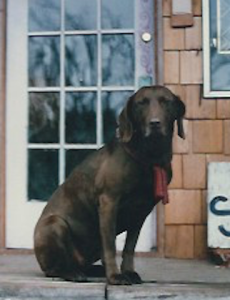 A friend gifted us that tree as a sapling about twenty years ago, to plant on the grave of our dog Magnolia, who spent 17 years as my husband’s faithful companion and about half that time sharing his affections with me. We buried her on a bank overlooking the studio so she could see him at work and now, every spring, the tree puts on a showy reminder of the dog that once played there. This spring I’ve had time enough to watch the entire show, from thick furry buds forming on the ends of her branches to the slow release of bright white stars.
A friend gifted us that tree as a sapling about twenty years ago, to plant on the grave of our dog Magnolia, who spent 17 years as my husband’s faithful companion and about half that time sharing his affections with me. We buried her on a bank overlooking the studio so she could see him at work and now, every spring, the tree puts on a showy reminder of the dog that once played there. This spring I’ve had time enough to watch the entire show, from thick furry buds forming on the ends of her branches to the slow release of bright white stars.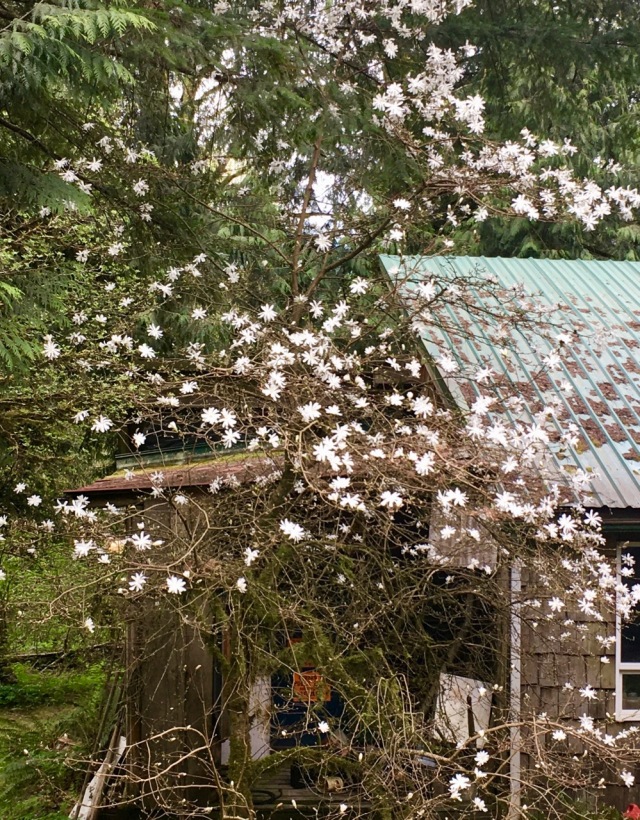










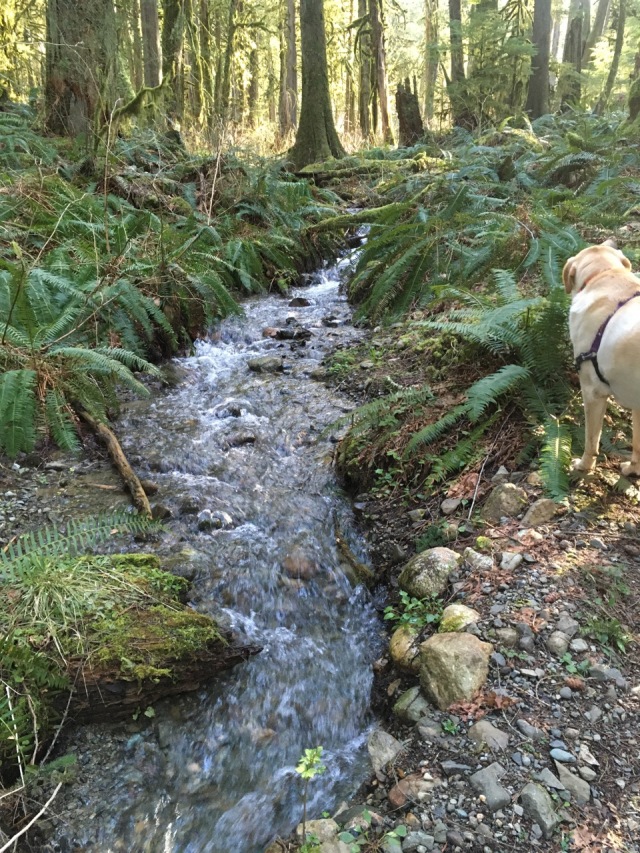









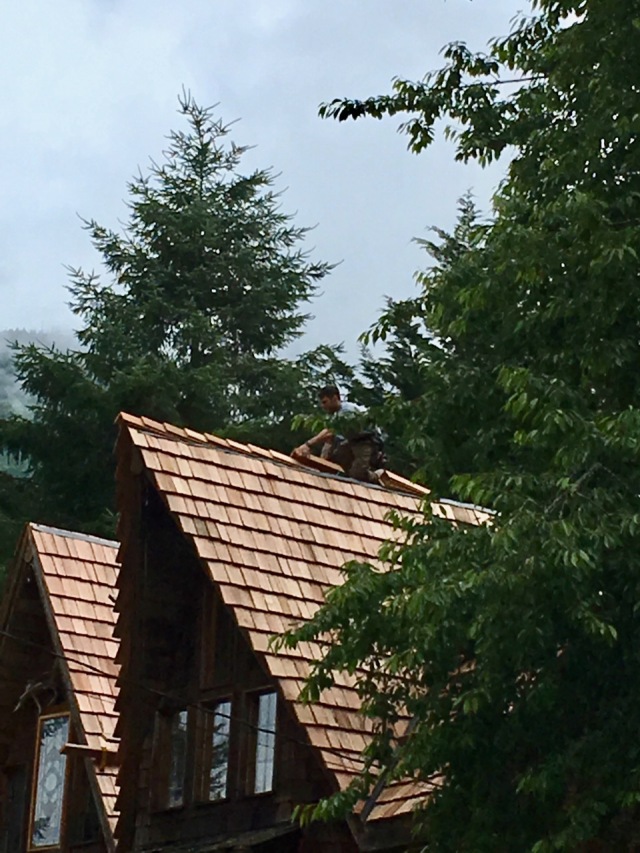








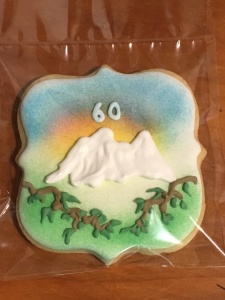
 I probably shouldn’t admit that on a blog because I suspect it reveals something I’d rather not reveal about my psyche but it does make me think I ended up living in the right house. Wouldn’t you say?
I probably shouldn’t admit that on a blog because I suspect it reveals something I’d rather not reveal about my psyche but it does make me think I ended up living in the right house. Wouldn’t you say?
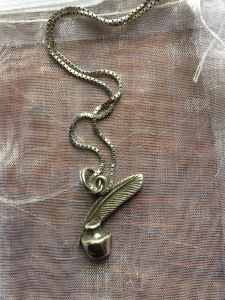 grilling my friend gave me in his non-specific rejection rattled my confidence, which surprised me because all I have to do is think of the actors and the time they give up to be a part of these previews to know that I’m well supported in this endeavor. Sarah and Dustin Moore left their brand new baby daughter with Grandma to come and perform in the preview: Carolyn Travis, who works two jobs as a vet tech and is a leading force in
grilling my friend gave me in his non-specific rejection rattled my confidence, which surprised me because all I have to do is think of the actors and the time they give up to be a part of these previews to know that I’m well supported in this endeavor. Sarah and Dustin Moore left their brand new baby daughter with Grandma to come and perform in the preview: Carolyn Travis, who works two jobs as a vet tech and is a leading force in 


